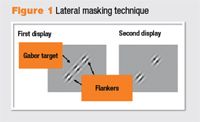Article
Training system designed to enhance quality of vision
Computer-based cortical vision training, also known as neural vision therapy, is a noninvasive treatment modality designed to enhance vision by modifying processes at the primary visual cortex.

Since the technology was developed in 1999, more than 1,500 patients have been treated in Europe, the United States, and Asia. The Singapore-based NVT company NeuroVision recently was purchased by RevitalVision, and operations were relocated to the United States.
RevitalVision's launch primarily has been focused on improving quality of vision and contrast sensitivity in post-IOL and post-LASIK patients (NeuroLASIK), and clinical studies to date have been promising.1 The company plans to release additional product offerings for the treatment of low myopia and early presbyopia as well as enhancement of night driving and sports vision.
Several studies have shown that the noise of individual cortical neurons can be modulated by appropriate choice of stimulus conditions and that contrast sensitivity can be increased through control of stimulus parameters.2-5
The interactive Web-based computer software program (RevitalVision) uses Gabor patches, a visual stimulus widely used in the field of visual neuroscience, to match and activate the shape of receptive fields in the visual cortex.

This lateral masking technique is tailored to an individual computerized training regimen using various stimulus (Gabor) parameters such as spatial frequency, spatial arrangement, contrast level, orientation (local and global), task order, context, and exposure duration.5
This precise control of stimulus conditions leading to increased neuronal efficiency is fundamental in initiating the neural modifications that are the basis for brain plasticity.





